| Omnidirectional Sensor |
Image Registration |
Isotropic |
Dynamic |
Image Resolution |
Notes |
| Rotating camera |
mechanical problems |
only for the single central column of pixels perpendicular to the rotation |
no, time delay
|
high when all columns are used
|
no good for dynamic scenes
|
|
Regular polyhedrons of mirrors and several cameras
|
complicated
|
no, combinations of mirrors are not circularly symmetrical
|
yes, when cameras are synchronised
|
medium
|
too many cameras
|
|
Catadioptric
|
ok, especially with single viewpoint
|
yes
|
yes
|
low
|
easily obstructed, potential mirror support and mirror registration problems
|
|
True fisheye
|
easy but the lens needs calibration/correction
|
yes
|
yes
|
very low at the periphery, medium to high in the centre
|
unobstructed hemispherical view
|






